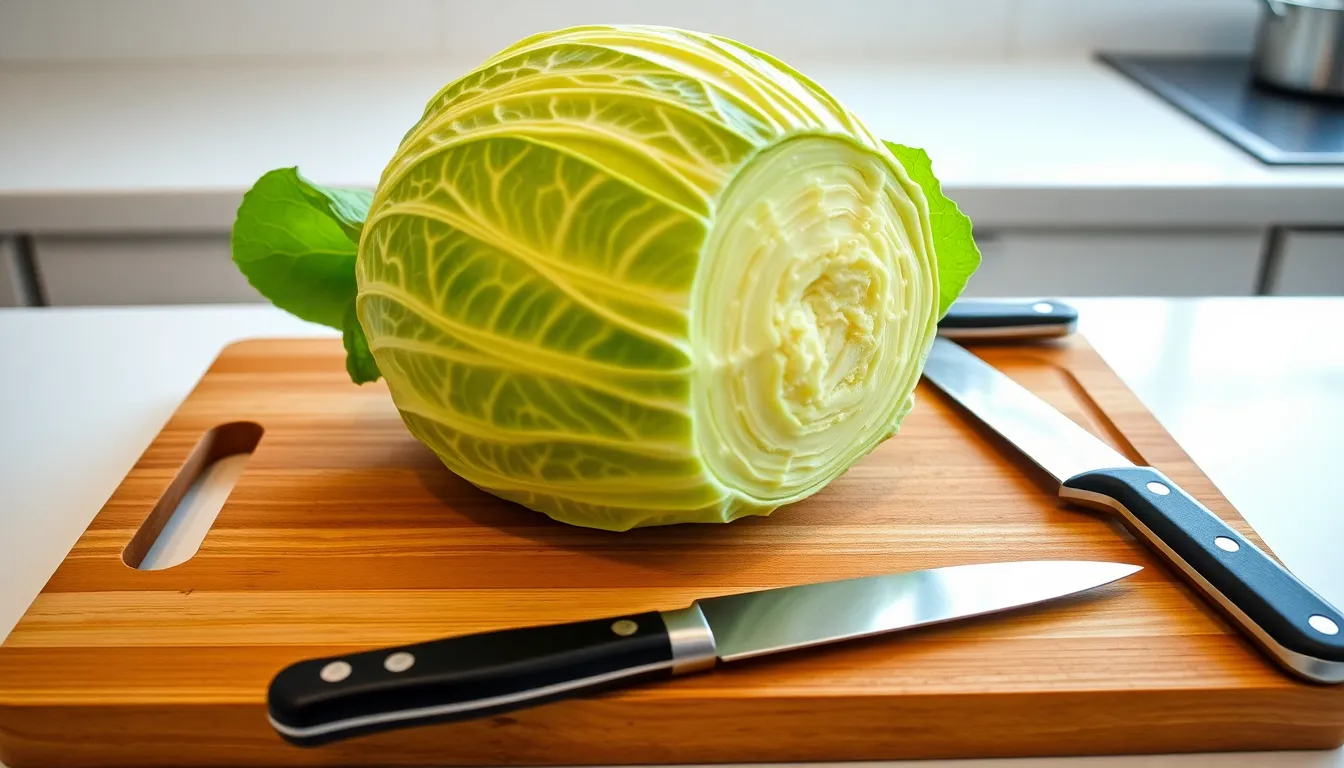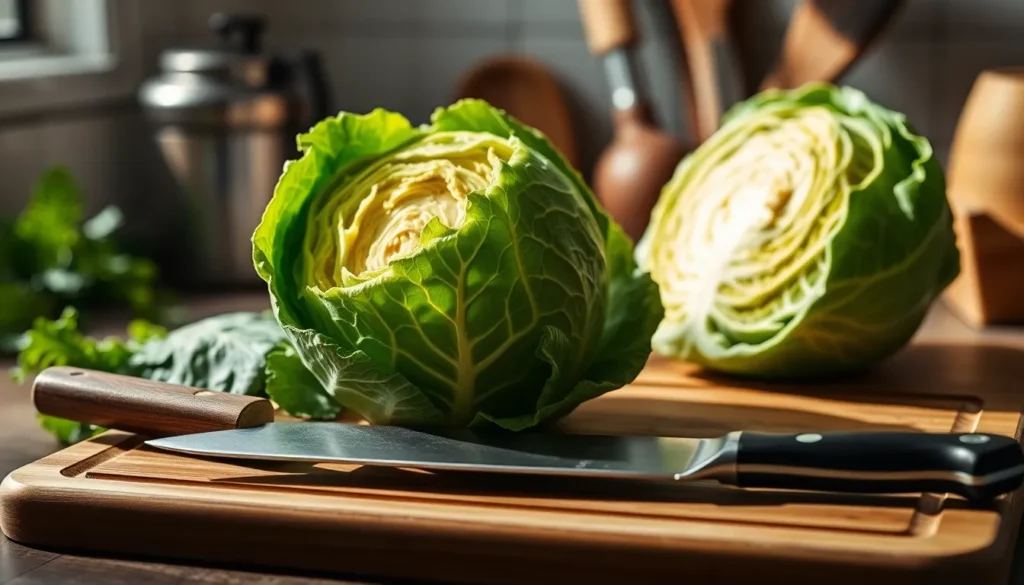Cabbage may not be the star of the show, but it’s the trusty sidekick that elevates corned beef to legendary status. Whether you’re preparing for a St. Patrick’s Day feast or simply craving a hearty meal, knowing how to cut cabbage properly can make all the difference. It’s time to embrace your inner chef and tackle this leafy green with confidence.
Table of Contents
ToggleUnderstanding Corned Beef and Cabbage
Cabbage plays a pivotal role as a side dish with corned beef, especially during St. Patrick’s Day and other hearty meals. Knowing how to cut cabbage correctly enhances the flavor and presentation of the dish.
The Importance of Cabbage in the Dish
Cabbage adds essential texture and flavor to corned beef. Its mild taste balances the richness of the meat, creating a harmonious meal. Nutritionally, cabbage contributes vitamins K and C, along with fiber. Incorporating cabbage also provides a colorful contrast on the plate, appealing to the eyes. Properly cut cabbage ensures even cooking and improves the overall enjoyment of this classic pairing.
Types of Cabbage to Use
Several types of cabbage work well with corned beef. Green cabbage serves as the traditional choice, known for its crisp leaves and mild flavor. Savoy cabbage offers a unique texture, featuring crinkled leaves that add visual interest. Napa cabbage presents a delicate flavor, ideal for those seeking a subtle twist. Choosing the right type of cabbage influences both taste and texture, enhancing this beloved dish.
Preparing the Cabbage

Preparing the cabbage properly enhances its flavor and texture in corned beef dishes. This process includes cleaning the cabbage and ensuring the right tools are available.
Cleaning and Removing Outer Leaves
Begin by rinsing the cabbage under cold running water. This step removes any dirt, pesticides, or insects present on the surface. After rinsing, pat it dry with a clean towel. Remove the outer leaves, as they often contain blemishes and imperfections. Discard any discolored or damaged leaves to maintain quality. Some cooks prefer removing a few layers to achieve the desired freshness. Inspection ensures the remaining cabbage is suitable for cutting. Maintaining cleanliness in preparation significantly impacts the final dish’s quality.
Tools Needed for Cutting
Using the right tools simplifies the cutting process. A sharp chef’s knife ensures clean, precise cuts. Cutting boards provide stability and protect countertops. A sturdy peeler aids in removing thick ribs if necessary. Some prefer a mandoline slicer for even, thin cuts. Having these tools ready before cutting makes the workflow efficient. Clean and sanitized tools help prevent contamination. The right setup leads to a well-prepared cabbage ready for cooking with corned beef.
Step-by-Step Guide on How to Cut Cabbage for Corned Beef
Cutting cabbage properly enhances its flavor and texture in corned beef dishes. Follow these steps to achieve the best results.
Cutting the Cabbage into Quarters
Start by placing the cabbage on a cutting board. Remove the core using a sharp chef’s knife. Next, cut the cabbage in half, followed by slicing each half into quarters. Ensure each quarter remains intact at the base to facilitate easier handling. This method creates manageable sections for slicing or shredding later.
Slicing the Cabbage
Begin slicing the cabbage quarters thinly. Use a steady hand to create even strips, typically about one-eighth to one-fourth inch thick. Focus on maintaining uniformity for consistent cooking. These slices mix well with corned beef, ensuring every bite includes both flavors. For an alternative texture, consider cutting thicker slices for a more substantial bite in the final dish.
Alternative Cutting Methods
Explore various cutting techniques based on personal preference. Shredding cabbage with a mandoline slicer produces fine, consistent pieces. Alternatively, using a food processor can expedite the process. For those desiring a rustic presentation, chopping the cabbage into larger chunks creates a hearty appearance. Each method offers unique textures and flavors that complement corned beef, allowing for creativity in meal presentation.
Cooking with Cut Cabbage
Cooking with cut cabbage enhances the overall flavor and texture of corned beef dishes. Numerous techniques exist to achieve the best results.
Best Techniques for Cooking
Sautéing cabbage adds a delicious caramelized flavor. Cooking it on medium heat for about 5-7 minutes yields tender yet crispy bites. Boiling cabbage in salted water brings out its natural sweetness, taking roughly 3-5 minutes for perfectly cooked pieces. Braising presents another great option. This method involves simmering cabbage in broth or stock, allowing it to absorb rich flavors. Roasting cabbage at 400°F for 25-30 minutes adds a savory crunch and depth. These various techniques enhance the dish while offering unique taste experiences.
Flavor Pairings
Pairing cabbage with flavorful ingredients elevates the dish. Mustard complements the richness of corned beef, adding a tangy contrast. Carrots provide a natural sweetness, harmonizing well with both cabbage and meat. Potatoes infuse heartiness into the meal, satisfying any appetite. Herbs such as thyme or bay leaves introduce aromatic layers, deepening flavor profiles. Adding vinegar or citrus brightens the overall flavor, balancing the richness. Combining these ingredients creates a vibrant and enjoyable meal.
Mastering the art of cutting cabbage for corned beef can transform a simple dish into a culinary delight. With the right techniques and tools at hand, anyone can create beautifully cut cabbage that enhances texture and flavor. Whether opting for traditional green cabbage or exploring varieties like Savoy and Napa, each choice adds its unique twist to the meal.
Incorporating cabbage not only elevates the dish but also adds nutritional value. By following the proper preparation and cutting methods, cooks can ensure a delicious and visually appealing side that complements the richness of corned beef. Embracing these tips will lead to a satisfying and memorable dining experience.



